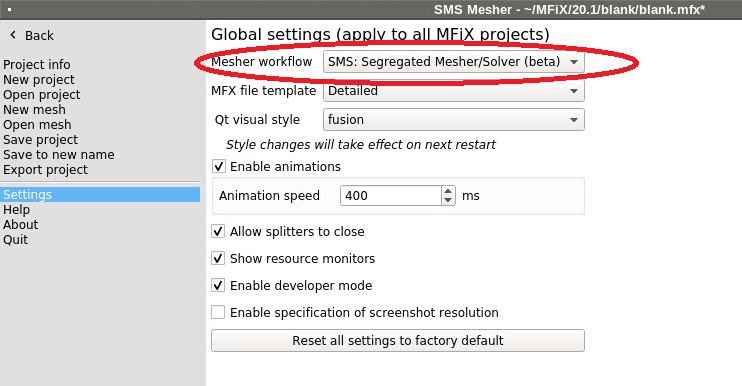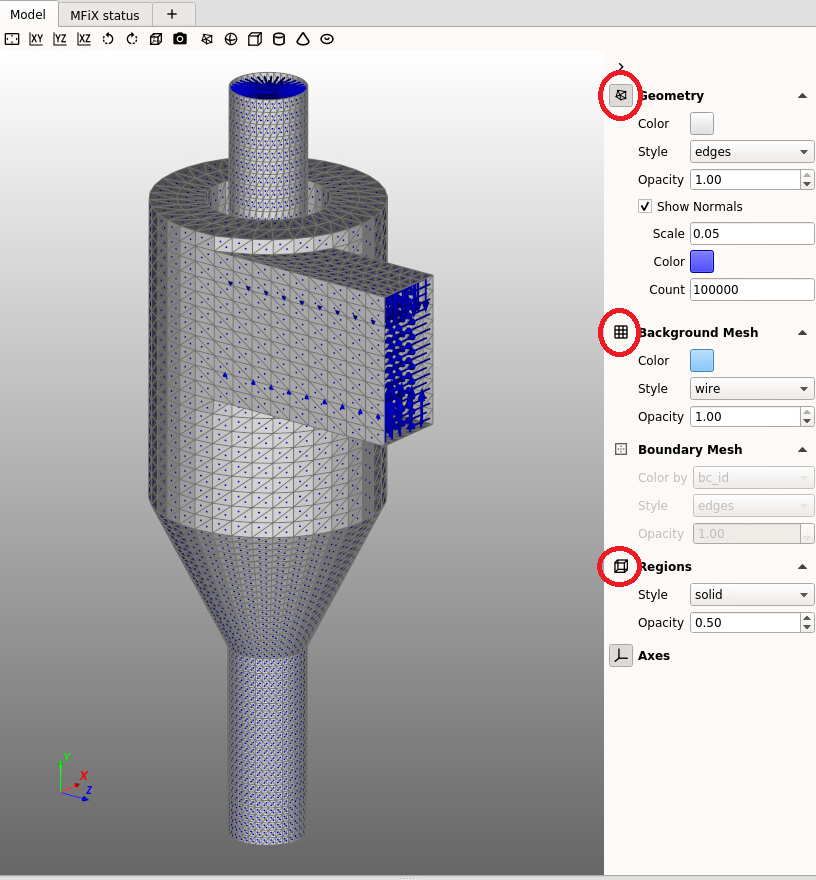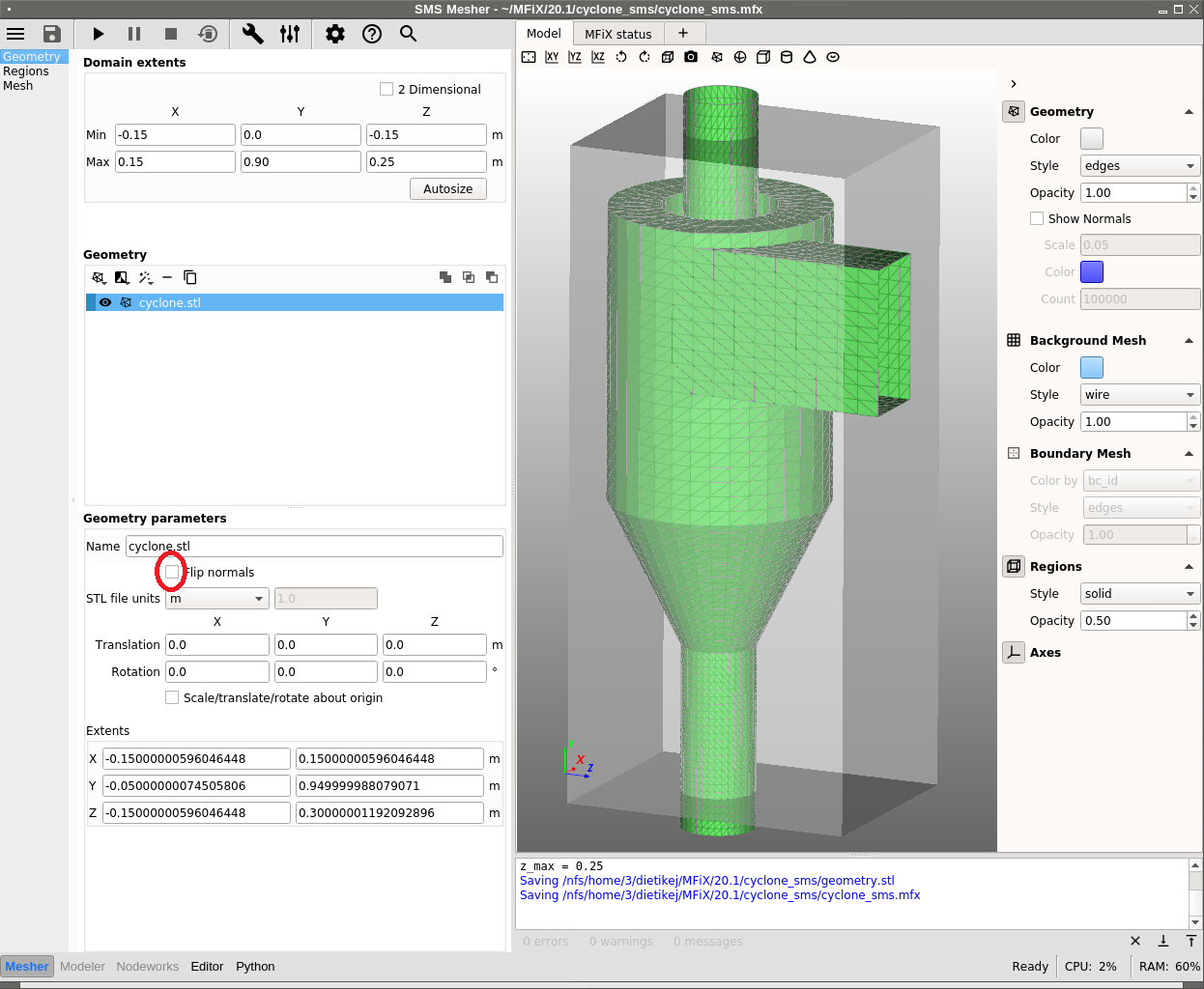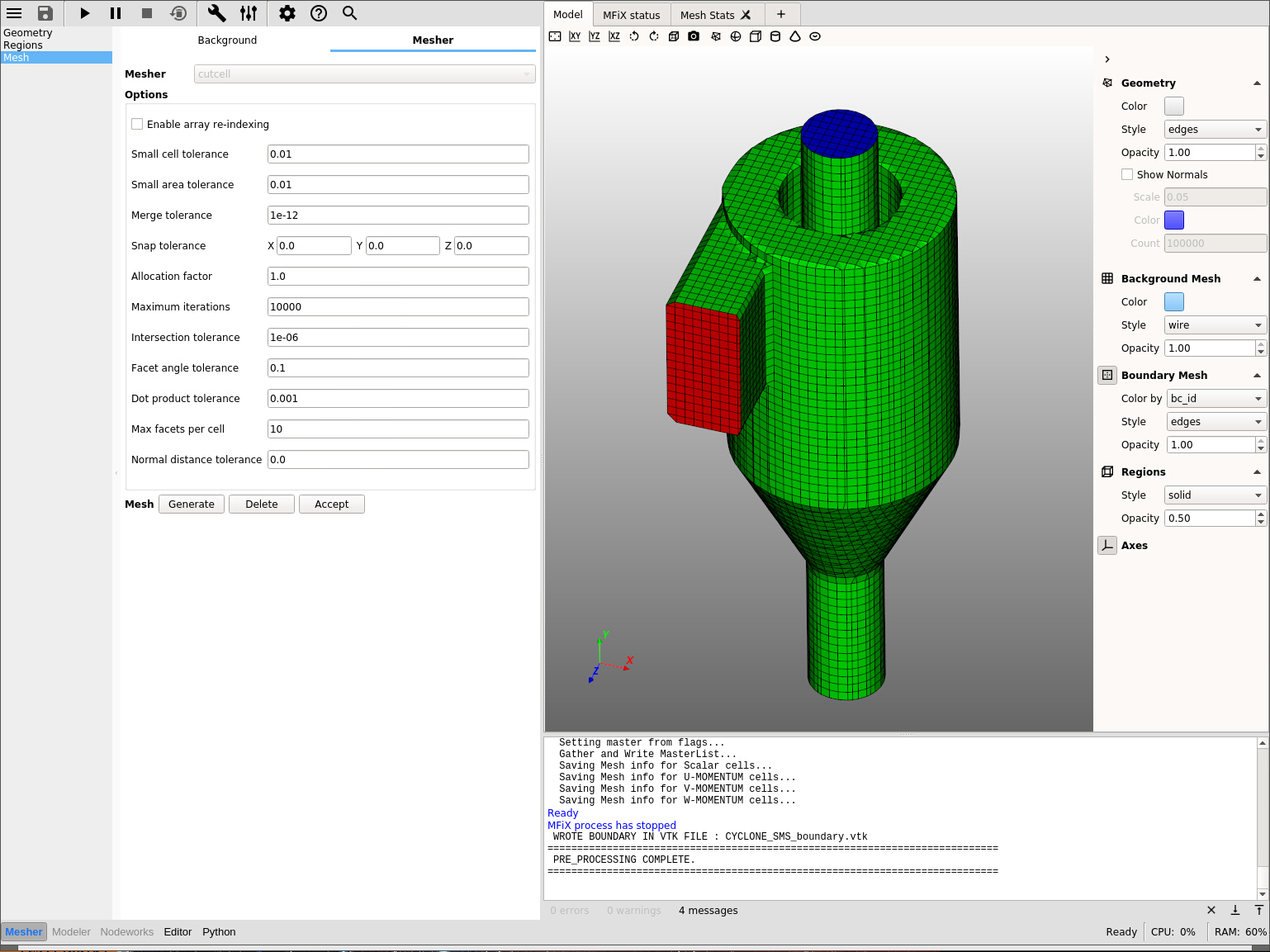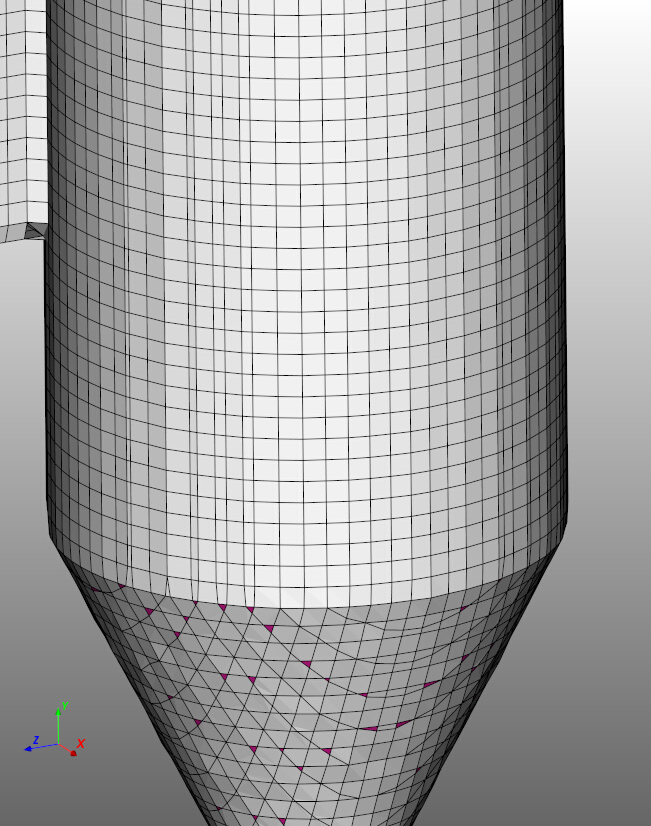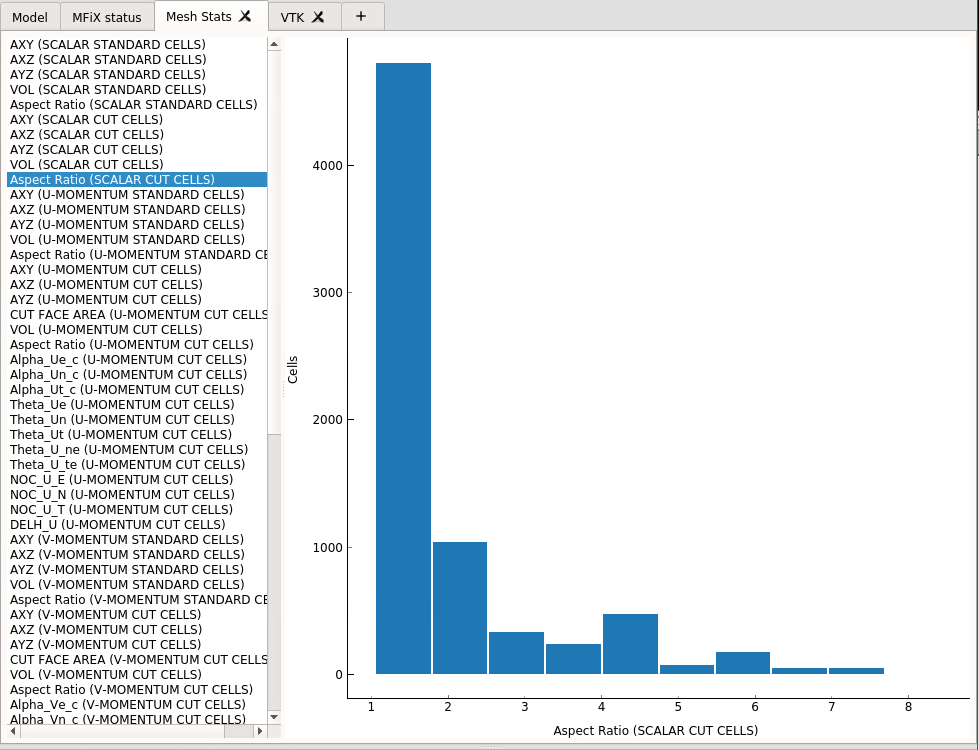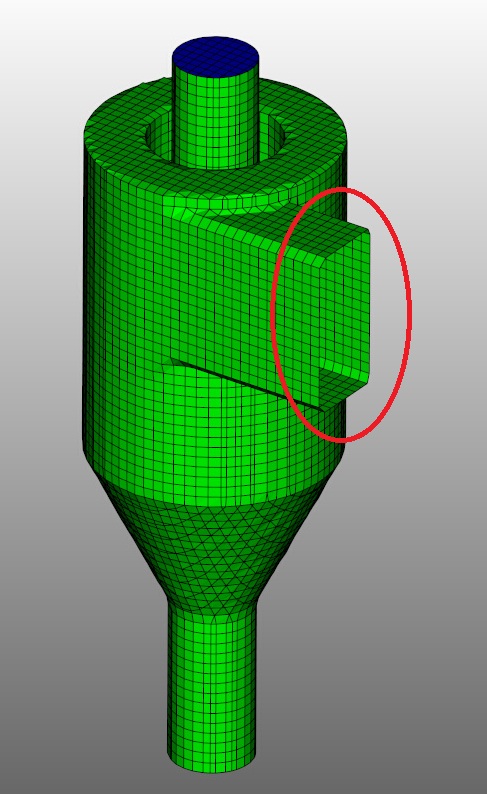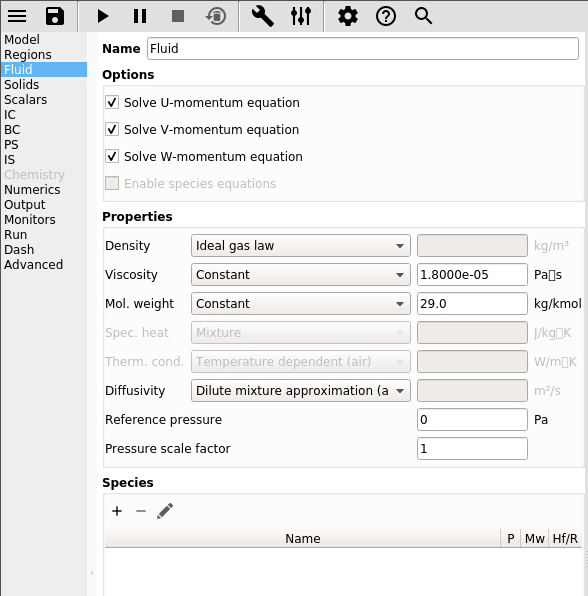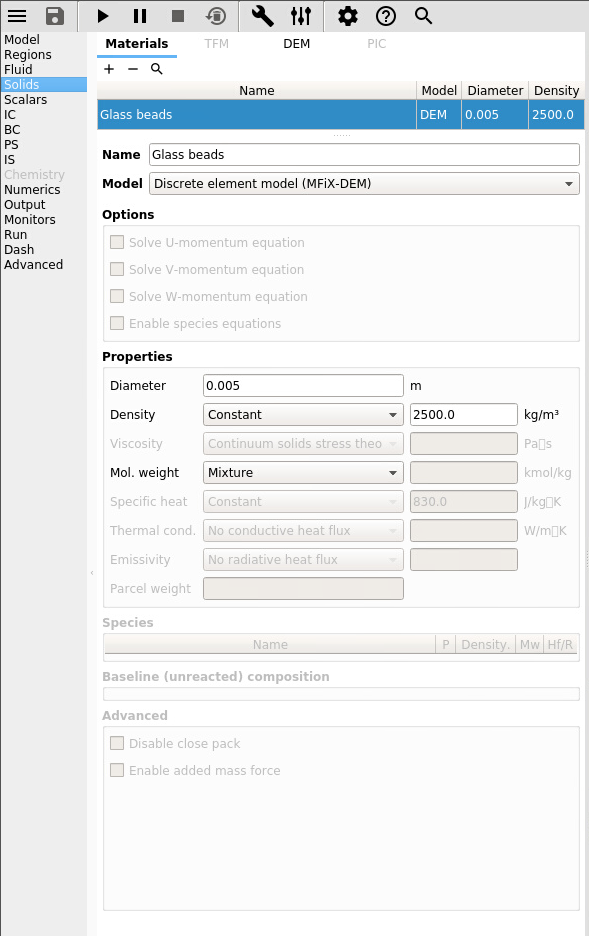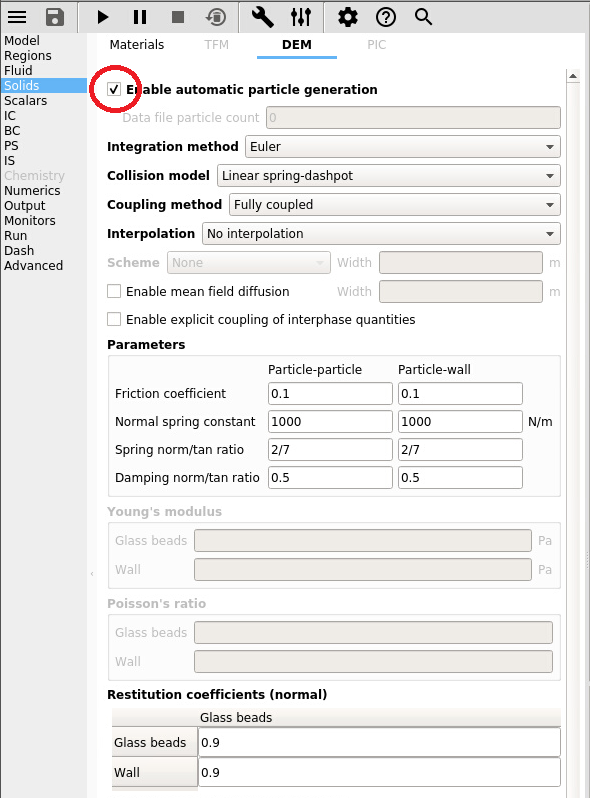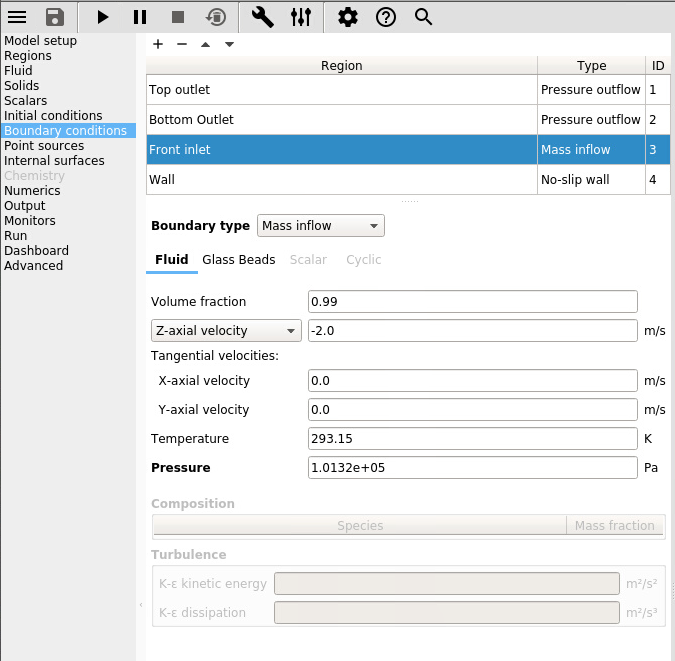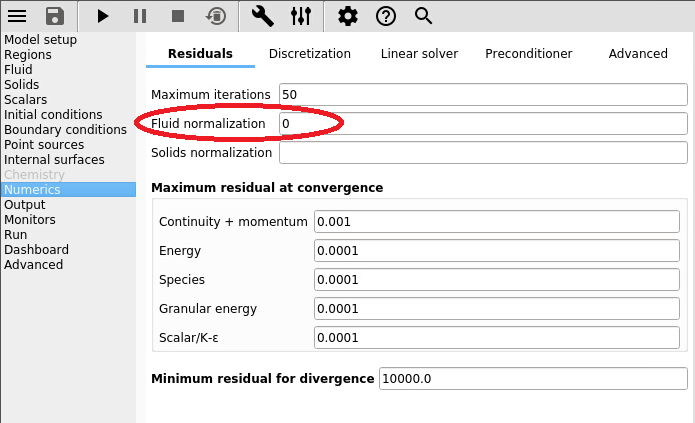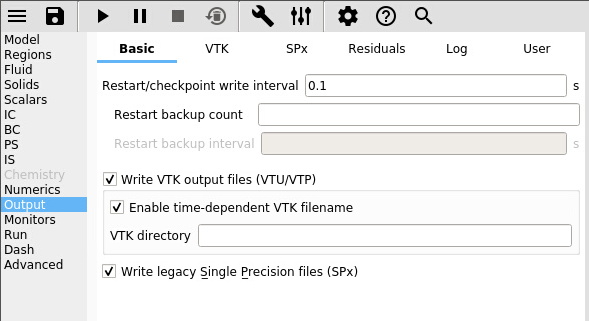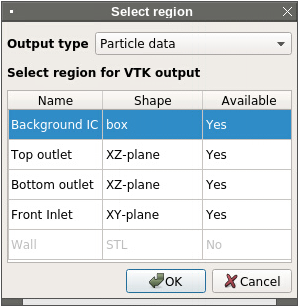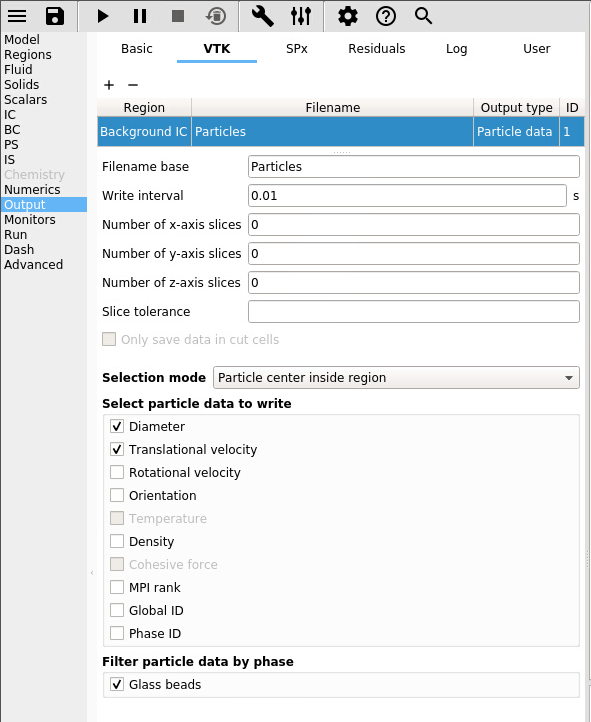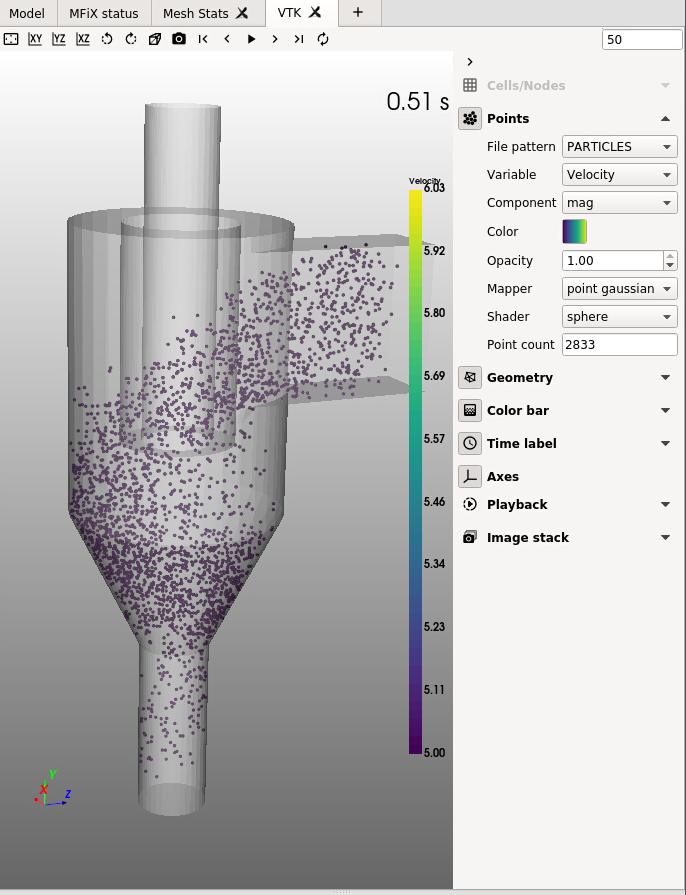3.8. SMS meshing workflow, cyclone, Discrete Element Model (DEM)¶
This tutorial shows how to use the new meshing workflow, called SMS (Segregated Mesher/Solver). The SMS workflow breaks the CFD workflow into two major steps: Mesher and Solver modes. Each mode of operation is performed in a separate tab in the GUI.
During the Meshing step, the user focuses on generating the mesh and verifies it is appropriate before moving on to the Solver setup. Only three panes are available during Meshing: Geometry, Regions, and Mesh. Once the mesh is generated it must be accepted (after inspection) to unlock the other panes, and move to the second step (Solver mode). The solver mode allows to set all other model settings, and run the MFiX solver to obtain and visualize the simulation results.
The SMS workflow is currently available as a beta testing feature, and can
be turned on from the settings menu (select SMS: Segregated Mesher/Solver (beta)
from the Mesher workflow drop down list). The blank template will automatically
prompt the user to use the SMS workflow and users are encouraged to try it and
provide feedback to the development team.
3.8.1. Create a new project¶
On the main menu click on the
New button.
Create a new project by double-clicking on “Blank” template.
Enter a project name (say ‘cyclone_sms’ and browse to a location for the new project.
If you have not switched to SMS workflow, you will be prompted to switch. Accept SMS mode.
We are now starting a new project in SMS workflow. There are two tabs in the GUI to setup and run the simulation. The Mesher tab is where the mesh is setup and generated. The Modeler tab is where the rest of the settings and the simulation are performed. The Modeler tab is initially locked until the mesh has been generated and accepted. Running the MFiX solver is also not allowed until the mesh has been generated. At run time, the solver will read the mesh and proceed with the CFD solution.
3.8.2. Import the geometry¶
We will use an STL file as the geometry input. Download the file here
Go to the Geometry pane:
Choose
STL fileas the geometry input.
Navigate to where you downloaded
cyclone.stl, select it and answerYeswhen prompted to copy the file to the project directory.Verify the STL normals are pointing in the right direction. In the model window, show the Geometry, hide the Background mesh, hide the Regions (visibility is toggled by clicking on each icon). Set the Geometry style to
edges, opacity to 1.0, check theShow normalsbox, set theScaleto 0.05, setcountto 10,000 (to show all normals).
The normal vectors should point towards the fluid region (here towards the inside of the cyclone). For internal flows, the tips of the arrows are generally not visible, except through openings in the STL geometry. Openings in the STL geometry are allowed as long as they are outside of the domain extents.
Note
When the normals are pointing in the wrong direction, they can be flipped in the Geometry parameters.
Check the Flip normals box and notice the difference in the Model view. Uncheck the box since the original STL
file was correctly oriented.
Toggle the Region visibility back on.
In
Domain extent, click on Autosize, and adjust the following:Enter
0.0for the Min Y value.Enter
0.9for the Max Y value.Enter
0.25for the Max Z value.
Note that the cyclone inlet and outlets extend beyond the domain extents. This is intentional, as it usually provides a cleaner intersection and easier way to define boundary conditions regions when they are aligned with the domain box (planes along x=xmin, x=xmax etc.).
Save the project by clicking the
button.
3.8.3. Create boundary conditions regions¶
Here, we need to define the mesh boundaries. Boundaries include the cyclone wall (curved surface defined by the STL geometry), and the inlet and outlets, defined along the domain outer box (plane boundaries). A boundary condition type must be defined, but it will be possible to change it later (in Modeler Tab). The actual boundary conditions (like the inlet velocity, or outlet pressure) do not need to be set at this point.
Go to the Regions pane:
There is already a
Background ICthat is predefined in the Blank template. We can ignore it for now.Click the
(top) button to create a new region to be used by pressure outflow boundary condition.
Select
Pressure outflowin theBoundary typedrop down menu.Enter a name for the region in the
Namefield (“Top outlet”).Change the region color to blue.
Adjust the From/To coordinates in the x-direction: From -0.07 to 0.07.
Adjust the From/To coordinates in the z-direction: From -0.07 to 0.07.
Click the
(bottom) button to create a new region to be used by another pressure outflow boundary condition.
Select
Pressure outflowin theBoundary typedrop down menu.Enter a name for the region in the
Namefield (“Bottom outlet”).Change the region color to yellow.
Adjust the From/To coordinates in the x-direction: From -0.07 to 0.07.
Adjust the From/To coordinates in the z-direction: From -0.07 to 0.07.
Click the
(front) button to create a new region to be used by mass inflow boundary condition.
Select
Mass inflowin theBoundary typedrop down menu.Enter a name for the region in the
Namefield (“Front inlet”).Change the region color to red.
Adjust the From/To coordinates in the x-direction: From xmin to -0.025.
Adjust the From/To coordinates in the y-direction: From 0.55 to 0.80.
Click the
(all) button to create a new region that covers the entire domain to be used for the wall boundary condition.
Select
No-slip wallin theBoundary typedrop down menu.Enter a name for the region in the
Namefield (“Wall”).Change the region color to green.
Check
Select facets (STL)andcyclone.stl, useallfor the selection method. You should see that there are 7554 facets selected.
Note
The pressure outlet and mass inflow boundaries are located along the domain box. They are defined as rectangular 2D regions and must overlap the actual boundary areas (intersection of the STL file with the box planes). The exact boundary area will be computed automatically when preprocessing is performed. Since there is only one boundary condition on the top, bottom and front planes, we could also have used the entire planes instead of adjusting the region coordinates.
Save the project by clicking the
button.
3.8.4. Setup the mesh¶
Go to the Mesh pane, Background sub-pane:
Enter
25for the x cell value.Enter
70for the y cell value.Enter
33for the z cell value.
Go to the Mesh pane, Mesher sub-pane:
Keep all default settings and click
Generate. Select the default solver, and clickRunLook at the console output to verify the mesh generation completed successfully.
In the Model view - hide the
Geometry,Background meshandRegions, - show theBoundary mesh- setColor bytobc_id, - setStyletoedgesand opacity to1.0.The boundary mesh should look like a closed surface with colors matching the boundary conditions regions.
Color the boundary mesh by
small_cell. This will show small cells, as defined by the small cell tolerance. The default value of 0.01 means a cut cell is considered small if its volume is below 0.01 times the volume of the corresponding standard, uncut cell. These small cells will be removed from the computation. Having a Small cell tolerance set to 0.0 will keep all small cells and this may lead to numerical stiffness and loss of convergence.
Having a few small cells is usually acceptable. In some cases it is possible to reduce the number of small cells by adjusting some cut cell parameters. Increase the Snap tolerance to 0.1 in the x, y, and z-direction. Generate the mesh again, and visualize the small cells. The vertical column of small cells was eliminated.
Mesh statistics (histogram) can be viewed in the Mesh Stats viewport. Various quantities are available. For example the aspect ratio of cut cells is between 1 and 8, with most aspect ratios between 1 and 2. This is acceptable.
After inspection, the mesh is deemed acceptable and we can move to the second step (Solver mode). Click Accept. This will unlock the Modeler tab.
Note
Optional but recommended: To see examples of unacceptable meshes, try the following:
Go back to the
Geometrypane, and flip the normals. This will incorrectly orient the STL file. This is a common error when importing STL files. Generate the mesh and visualize the boundary mesh. Having an open surface and boundaries inside-out is an indication that the normals are not properly oriented. The mesh should not be accepted.
Uncheck the
Flip normalsbox in the Geometry pane to get correct orientation. Go to the Region pane, and select the Front inlet region in the region table and set theBoundary typetoNone. Save the project and generate the mesh. The boundary mesh will look like an open surface, this is an indication a boundary condition is missing. The mesh should not be accepted.
Remember to set the Front inlet region boundary type to Mass inflow again before continuing.
Generate the mesh, inspect it and accept it before moving to the Modeler tab.
3.8.5. Model settings¶
Switch to the Modeler tab (second tab at the bottom left corner of the GUI).
On the
Modelpane, enter a descriptive text in theDescriptionfield.Select “Discrete Element Model (MFiX-DEM)” in the
Solverdrop-down menu.Keep all other settings at their default values.
3.8.6. Regions settings¶
We already have the Background_IC region that is predefined. We will use it to initialize the flow field. We have defined all Boundary Condition regions during the meshing step. There are no other regions that need to be defined in this tutorial. We will re-use Background_IC region for the VTK output file.
3.8.7. Fluid settings¶
Change Density to
Ideal gas law.Keep all other settings at their default values.
3.8.8. Solids settings¶
On the Solids pane, Materials sub-pane:
Click the
button to create a new solid.
Enter a descriptive name in the
Namefield (“Glass beads”).Verify the solids model is already set to “Discrete Element Model (MFiX-DEM)”.
Enter the particle diameter of
0.005m in theDiameterfield.Enter the particle density of
2500kg/m3 in theDensityfield.
Select the
Solidspane,DEMsub-pane.Check the
Enable automatic particle generationcheckbox. Although we will start with an empty cyclone, this setting is necessary so we don’t attempt to read initial particle location fromparticle_input.dat.Keep all other settings at their default values.
3.8.9. Initial Conditions settings¶
On the Initial conditions pane:
There is already a pre-defined “Background IC” region. This will initialize the entire flow field with air at rest.
Keep all settings at their default values.
3.8.10. Boundary Conditions settings¶
On the Boundary conditions pane:
The Top outlet and Bottom outlet Boundary Conditions are already set to atmospheric pressure. No changes are needed.
The Wall Boundary Conditions is already set to No-slip wall. No changes are needed.
Select the Front Inlet region from the list.
In the Glass beads tab: set the Volume fraction to 0.01, and Z-axial velocity to -2.0.
In the Fluid tab, verify the Gas volume fraction was automatically set to 0.99 and set the Z-axial velocity to -2.0.
Keep all other settings at their default values.
3.8.11. Numerics settings¶
On the Numerics pane:
Set the Fluid normalization to 0.0.
Keep all other settings at their default values.
3.8.12. Output settings¶
On the Output pane:
On the
Basicsub-pane, check theWrite VTK output files (VTU/VTP)checkbox.
Select the
VTKsub-pane.Create a new output by clicking the
button.
Select “Particle Data” from the ‘Output type’ drop-down menu.
Select the “Background IC” region from the list to save all the particle data.
Click
OKto create the output.
Enter a base name for the
*.vtufiles in theFilename basefield (“Particles”).Change the
Write intervalto0.01seconds.Select the
DiameterandTranslational Velocitycheck-boxes.
3.8.13. Run settings¶
Save the project by clicking the button.
On the Run pane:
Set
Stop timeto1.0.Set
Time stepto0.01.Set
Maximum time stepto0.01.Keep all other settings at their default values.
3.8.14. Run the simulation¶
Run the project by clicking the
button.
On the
Rundialog, select the executable from the combo-box.Click the
Runbutton to actually start the simulation.
3.8.15. View results¶
Results can be viewed, and plotted, while the simulation is running.
Create a new visualization tab by pressing the
next to the Model tab.
Click the
3D viewbutton to view the vtk output files.On the
VTKresults tab, the visibility and representation of the*.vtkfiles can be controlled with the menu on the side.Change frames with the
,
,
, and
buttons.
Click the
button to play the available vtk files.
Change the playback speed under the
section on the sidebar.
